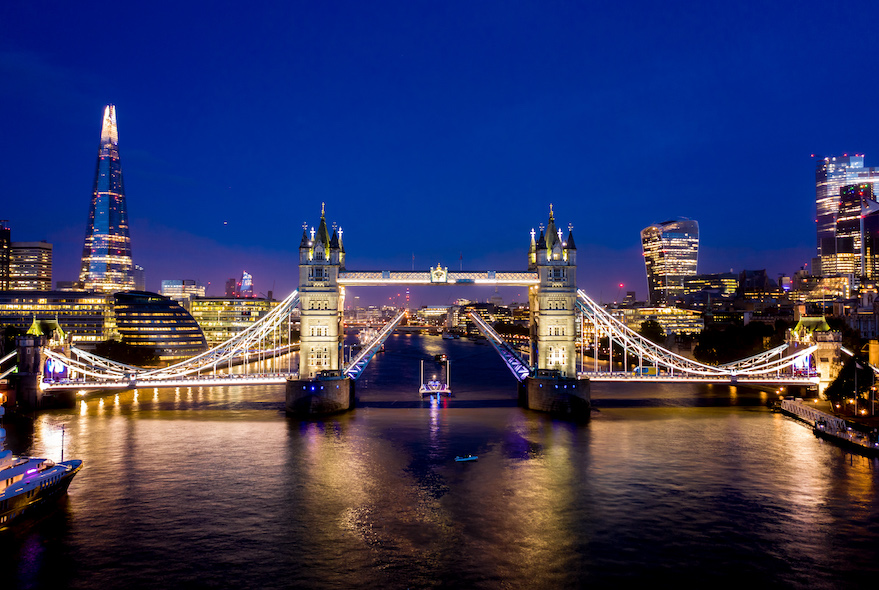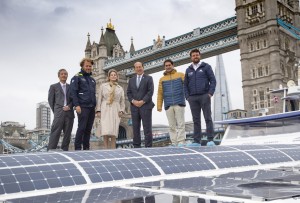- Energy Observer, the first hydrogen boat to go around the world is in London
- London, the iconic 47th stop
- Boat is moored from the 5th to 13th October 2019 at St. Katherine Docks
- An exhibition is set up and accessible to all to discover the boat and its Odyssey for the future
Having sailed 18,000 nautical miles since leaving Saint-Malo in 2017, Energy Observer has come to London for the final leg of its 2019 tour in Northern Europe. This floating laboratory, a harbinger for the energy systems of tomorrow, is docked under Tower Bridge, an exceptional location in the heart of the capital, following its remarkable arrival on the Thames. It is accompanied by its traveling exhibition, which will be located at St. Katharine Docks and freely accessible to the general public.
The expedition in Northern Europe was marked by many highlights, including the voyage last August to Spitsbergen (in the Arctic) in complete autonomy, powered solely by renewable energy and hydrogen – without emissions, without fine particles and without noise. A world first!
“Energy Observer’s Future Odyssey aims to accelerate energy transition through the deployment of renewable energies and green hydrogen, as well as the implementation of the 17 Sustainable Development Goals as set by the United Nations in its 2030 Agenda. This stopover in Svalbard, a real global climate barometer with temperatures increasing 2 to 3 times faster than anywhere else, reminded us of the urgency to act on a universal level and to implement solutions available now to accelerate our necessary move to ecological and energy transition. “
Jérôme Delafosse, Energy Observer Expedition Leader and Director
The third year of navigation is coming to an end in the British capital, which has in place an ambitious policy to support energy transition thanks to the use of hydrogen and renewable energies. The city is also home to the headquarters of the International Maritime Organization, which is setting up targets to reduce the speed of shipping vessels in order to reduce the sector’s CO2 emissions.
“London, the last stopover in our Northern Europe tour. What a long way we have come! Energy Observer was able to discover the many initiatives deployed by the major capitals of Northern Europe in terms of energy and environmental transition. We also managed a navigation of 5700 km from Saint-Petersburg to Spitsbergen in the Arctic in total autonomy! A symbolic moment that reminds us of the urgency to act in the face of climate change, which is particularly prominent in this polar zone. We are very happy to arrive in the UK and discover all the initiatives that are being undertaken here, such as the first ever HydroFLEX hydrogen train, a prototype train that will replace diesel trains to decarbonize the British rail network by 2040. And we are honoured to have both the IRENA and IMO present at this press conference, each playing a major role in energy transition on land and at sea “.
Victorien Erussard, President, Founder and Captain of Energy Observer
In the United Kingdom, for several years, private companies and public authorities have been involved in the development of renewable energies. And so the country has reduced its CO2 emissions by 38% since 1990. It’s better than any other industrialized country! 2019 is announced as the year in which renewable energies will exceed fossil fuels for the first time. With the objective of increasing the share of renewables to 80% by 2030 – half of which is offshore wind energy – and achieving carbon neutrality by 2050.
Energy Observer operates thanks to a revolutionary energy mix composed of three sources of renewable energy (solar, wind, hydro-generation) and a complete chain of carbon-free hydrogen (produced by seawater electrolysis). The boat emits no CO2 emissions, no fine particles and no noise that could disturb the underwater fauna.
The OceanWings wings have proved their worth, especially when sailing in the Arctic, as they optimize the energy input of the wind (by up to 42%) and save energy traditionally allocated to the propulsion of the boat, thus making it possible to produce hydrogen while sailing.
Carbon-free hydrogen has huge potential to support a sustainable energy transition. Diversity is a source of resilience, so the energy mix developed on Energy Observer shows that practical alternatives to fossil fuels do exist and can be developed both on land and at sea. Energy Observer, a clean tech laboratory, has implemented and tested efficient systems. It offers viable solutions to accelerate the energy transition, one of the biggest challenges of the 21st century.






